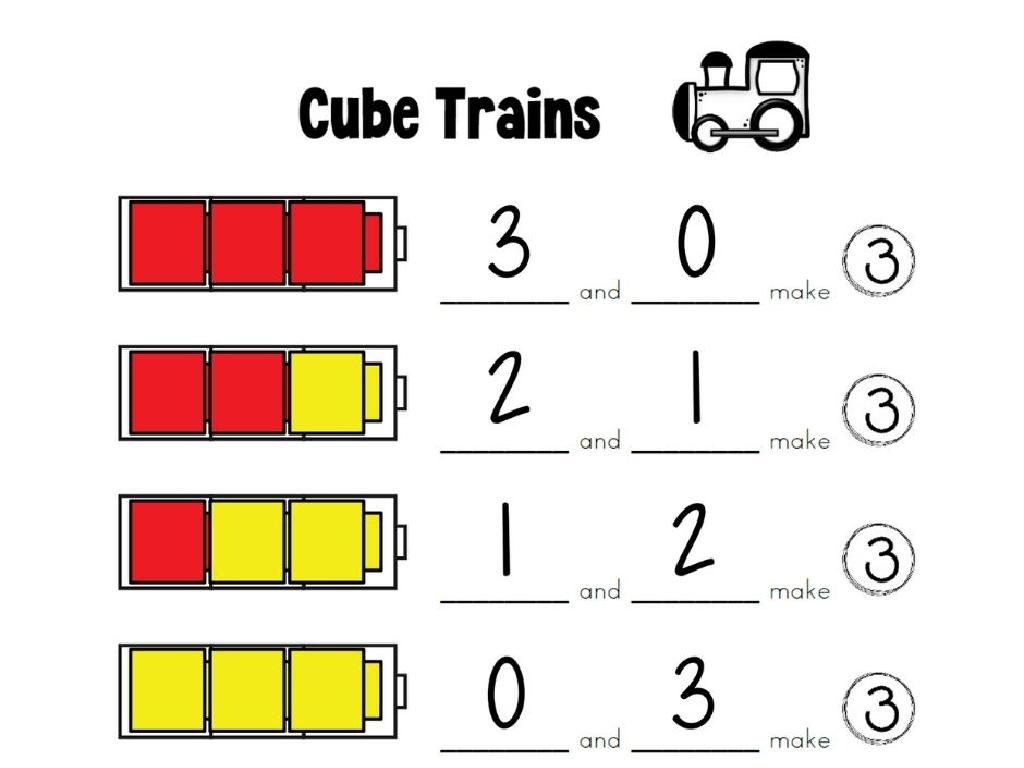Write Multiplication Expressions Using Exponents
Subject: Math
Grade: Sixth grade
Topic: Exponents
Please LOG IN to download the presentation. Access is available to registered users only.
View More Content
Welcome to Exponents!
– Exponents represent repeated multiplication
– Instead of 2 x 2 x 2, we write 2^3
– Simplifying with exponents
– 3^4 is shorter than 3 x 3 x 3 x 3
– Exponents in the real world
– Used in area calculations, scientific notation
– Practice exponent problems
– Solve 4^2 or 5^3 to understand exponents better
|
Introduce students to the concept of exponents as a way to express repeated multiplication. Explain that exponents make it easier to write and calculate long multiplication expressions. Provide examples of how exponents are used in real-life scenarios, such as calculating the area of squares or cubes and in scientific notation for large or small numbers. Encourage students to practice writing and solving exponent expressions to become comfortable with the concept. The goal is for students to recognize the efficiency and practicality of using exponents in mathematics.
Understanding Exponents
– Exponent definition
– An exponent shows how many times a number, the base, is multiplied by itself.
– Exponential expression parts
– Base: the number being multiplied; Exponent: the number of times it’s multiplied
– Example: 2^3
– 2^3 is 2 multiplied by itself 3 times, which equals 8.
|
Begin the lesson by defining an exponent and explaining its purpose in mathematics. Make sure to clarify the terms ‘base’ and ‘exponent’, as understanding these parts is crucial for grasping the concept of exponential expressions. Use the example 2^3 to visually show students that 2 is the base and is multiplied by itself as many times as the exponent indicates, in this case, three times. Emphasize that exponents are a shorthand way to express repeated multiplication, which can make calculations easier and more efficient. Encourage students to come up with additional examples and to practice writing exponential expressions to solidify their understanding.
Writing Multiplication as Exponents
– Spot repeated multiplication
– Look for the same number multiplied over and over, like 3 x 3 x 3
– Count the multiplications
– How many times does the number appear? For 3 x 3 x 3, it’s 3 times
– Express with exponents
– Write the base and exponent, like 3^3 for 3 x 3 x 3
– Practice with examples
– Try converting 2 x 2 x 2 x 2 and 5 x 5 into exponent form
|
This slide introduces students to the concept of exponents as a way to write repeated multiplication more succinctly. Start by explaining that exponents are a shorthand for saying how many times to use a number in a multiplication. It’s important to ensure that students can identify when a number is being multiplied by itself repeatedly and then count the occurrences. This count becomes the exponent, with the number itself being the base. Provide several examples for the students to practice, such as converting 2 x 2 x 2 x 2 into 2^4 and 5 x 5 into 5^2. Encourage students to work through these examples and check their understanding by expanding the exponents back into the original multiplication to verify their answers.
Practice with Exponents
– Convert 4 x 4 x 4 to an exponent
– 4 raised to the power of 3 is 4^3
– Write 3 x 3 x 3 x 3 in exponential form
– 3 raised to the power of 4 is 3^4
– Express 5 x 5 using an exponent
– 5 raised to the power of 2 is 5^2
|
This slide provides practice examples for students to convert repeated multiplication into exponential form. The first example shows how to express 4 multiplied by itself three times as 4 to the power of 3, written as 4^3. The second example demonstrates converting four 3s multiplied together into 3 to the power of 4, or 3^4. The third example asks students to write 5 multiplied by itself as an exponent, which is 5 squared or 5^2. Leave the fourth content point blank as only three examples are provided. Encourage students to identify the base number and count how many times it appears as a factor to determine the exponent. These exercises will help solidify their understanding of writing multiplication expressions using exponents.
Rules of Exponents
– Multiplying same bases: add exponents
– For 3^2 * 3^3, add 2 + 3 to get 3^5
– Dividing same bases: subtract exponents
– For 5^4 / 5^2, subtract 2 from 4 to get 5^2
– Zero exponent rule: any number^0 = 1
– Remember, anything raised to zero is always one
|
This slide introduces the fundamental rules of exponents, which are crucial for simplifying expressions in algebra. When multiplying terms with the same base, we add the exponents to combine them. For example, x^2 multiplied by x^3 is x^(2+3), which simplifies to x^5. When dividing, we subtract the exponent of the denominator from the exponent of the numerator. The zero exponent rule is a unique case where any non-zero base raised to the power of zero equals one. It’s important to practice these rules with different bases to help students internalize the concepts. Provide examples and let students try out problems to apply these rules.
Let’s Practice Exponents Together!
– Interactive example with 7^3
– 7 x 7 x 7 can be written as 7^3, which means 7 multiplied by itself 3 times.
– Group activity: Exponential hunt
– Look around the classroom for patterns or objects that can be expressed as exponents.
– Pair work: Create 5 exponent expressions
– Work with a partner to write five different multiplication expressions using exponents.
– Share and discuss your findings
|
This slide is designed for an interactive class activity to reinforce the concept of writing multiplication expressions using exponents. Start with an interactive example by writing 7 x 7 x 7 on the board and showing how it simplifies to 7^3. Then, have students search the classroom for items that come in squares or cubes and write them as exponential expressions. Next, students will pair up to create five unique multiplication expressions using exponents. Encourage creativity and exploration. Finally, have a few pairs share their expressions with the class to foster discussion and ensure understanding. Possible activities: counting tiles, books in a stack, or repeating patterns on a wallpaper.
Exponents in the Real World
– Exponents in computer science
– Used to represent large data sizes, e.g., kilobyte (10^3), megabyte (10^6)
– Scientific notation and exponents
– Express very large or small numbers, e.g., Avogadro’s number 6.02 x 10^23
– Calculating area with exponents
– Area of a square (side^2) or cube’s surface area (6 x side^2)
– Exponents in volume computation
– Volume of a cube (side^3) or other 3D shapes using exponents
|
This slide aims to show students the practical applications of exponents in various fields. In computer science, exponents are used to denote large quantities of data storage. Scientific notation, which uses exponents, is essential for dealing with extremely large or small numbers in science, such as in chemistry with Avogadro’s number. When it comes to geometry, exponents are used to calculate the area of squares and the surface area of cubes, with the exponent indicating the number of dimensions. Similarly, volume calculations for cubes involve exponents. Encourage students to think of other areas where exponents might be used and to practice these applications with real-world examples.
Class Activity: Exponent Scavenger Hunt
– Search for exponent-related items
– Create exponential expressions
– For example, a stack of books might be 2^3 if there are 8 books
– Share findings with classmates
– Reflect on the activity
– Think about how exponents are used in real life
|
This interactive activity is designed to help students recognize the use of exponents in everyday objects and settings. Students will search the classroom for items that can be associated with exponential expressions. For instance, they might find a dozen eggs and express it as 2^2 * 3, or a pack of 16 markers as 2^4. After finding items, they will create their own exponential expressions. Encourage creativity and ensure they understand the base and exponent concept. Once they have their expressions, students will share with the class, explaining their thought process. This will foster a collaborative learning environment and help students learn from each other. Possible variations of the activity could include finding patterns in floor tiles, counting windows, or grouping classroom supplies. The reflection at the end will help them internalize the concept of exponents.
Review and Q&A: Exponents Recap
– Recap today’s exponent concepts
– Open floor for student questions
– Work through more exponent examples
– For instance, 3^4 means 3 multiplied by itself 4 times
– Summarize lesson takeaways
– Remember, exponents show how many times to use a number in a multiplication
|
This slide is meant to consolidate the learning from today’s lesson on writing multiplication expressions using exponents. Begin by summarizing the key points, such as the definition of an exponent and how it represents repeated multiplication. Encourage students to ask any questions they have about the material to clarify their understanding. Be prepared to provide additional examples to ensure comprehension. For example, you might demonstrate how 2^3 is 2 multiplied by itself three times (2 x 2 x 2). Conclude by reiterating the importance of exponents in mathematics and their practical applications. This interactive session will help reinforce the concepts and prepare students for applying exponents in different mathematical scenarios.
Homework: Mastering Exponents
– Complete exponent worksheet
– Finish the provided problems on expressing multiplications with exponents
– Study for the upcoming quiz
– Quiz will cover all exponent rules learned
– Find daily life exponent examples
– Look for patterns or repeated multiplication in real-world scenarios
– Review and practice problems
|
This homework assignment is designed to reinforce students’ understanding of writing multiplication expressions using exponents. The worksheet will provide a variety of problems to practice converting repeated multiplication into exponential form. Students should also prepare for a quiz that will test their knowledge of the exponent rules we’ve covered in class. Additionally, finding examples of exponents in daily life, such as the growth of bacteria or cell division, will help students see the practical application of what they’re learning. Encourage them to review their class notes and textbook examples to solidify their understanding. Provide some practice problems during class to ensure they are well-prepared for the quiz.




